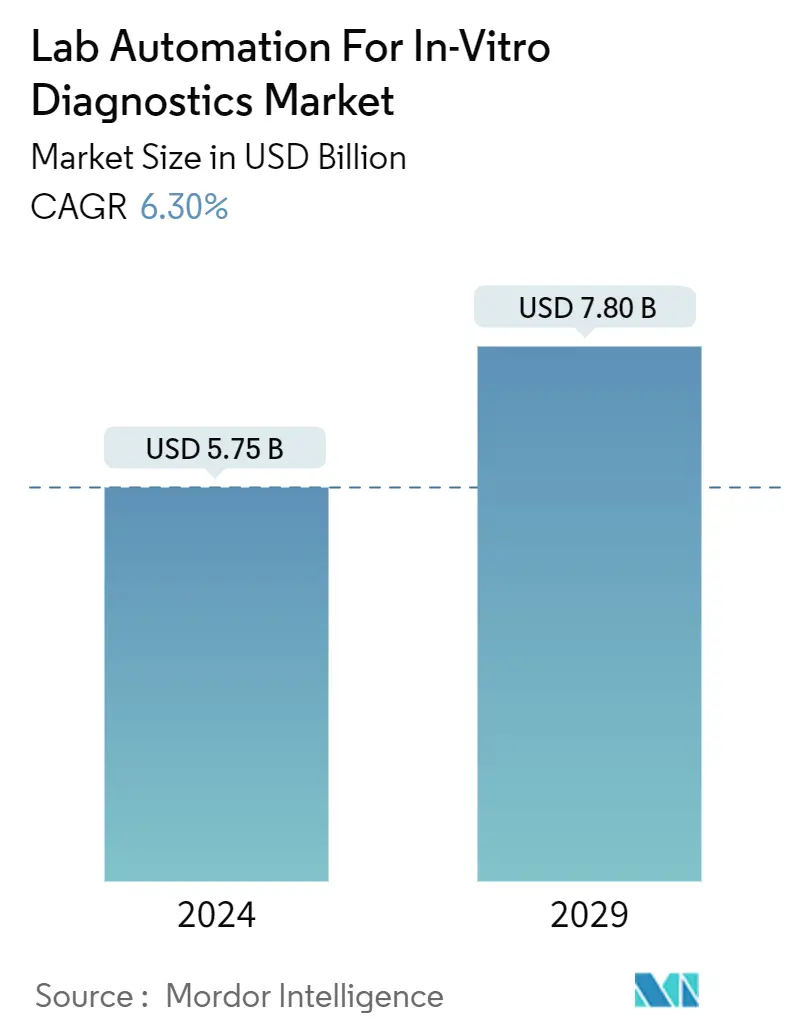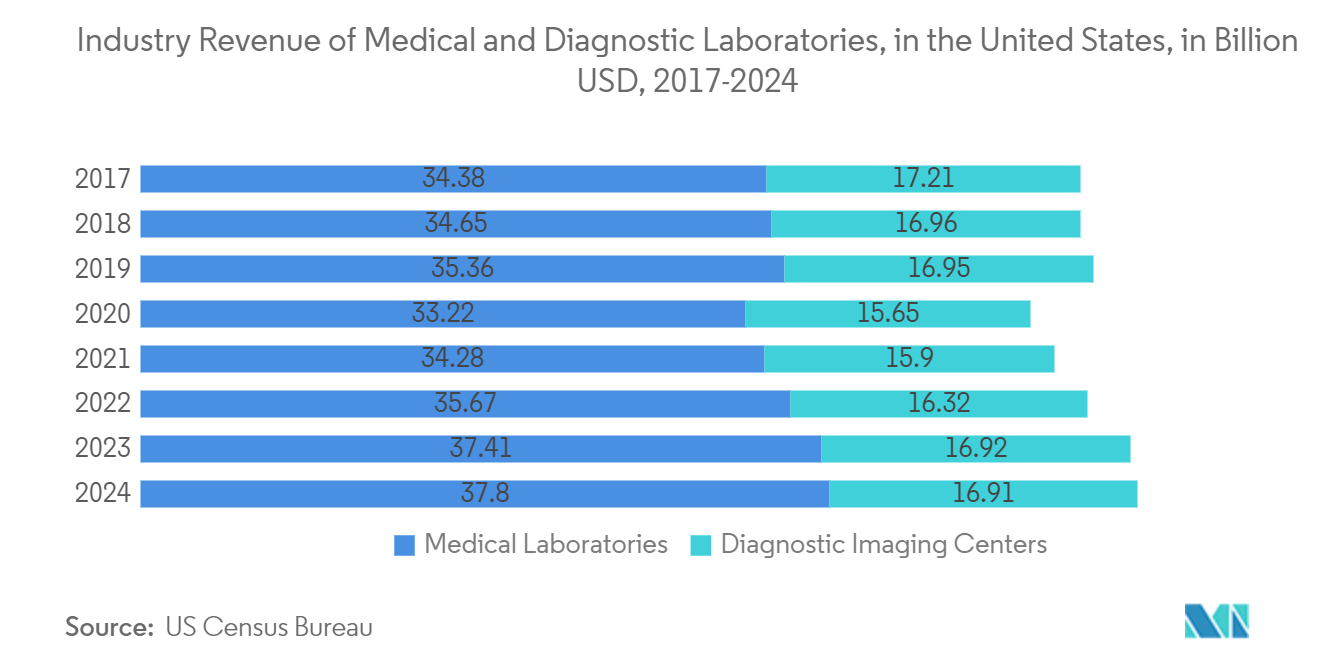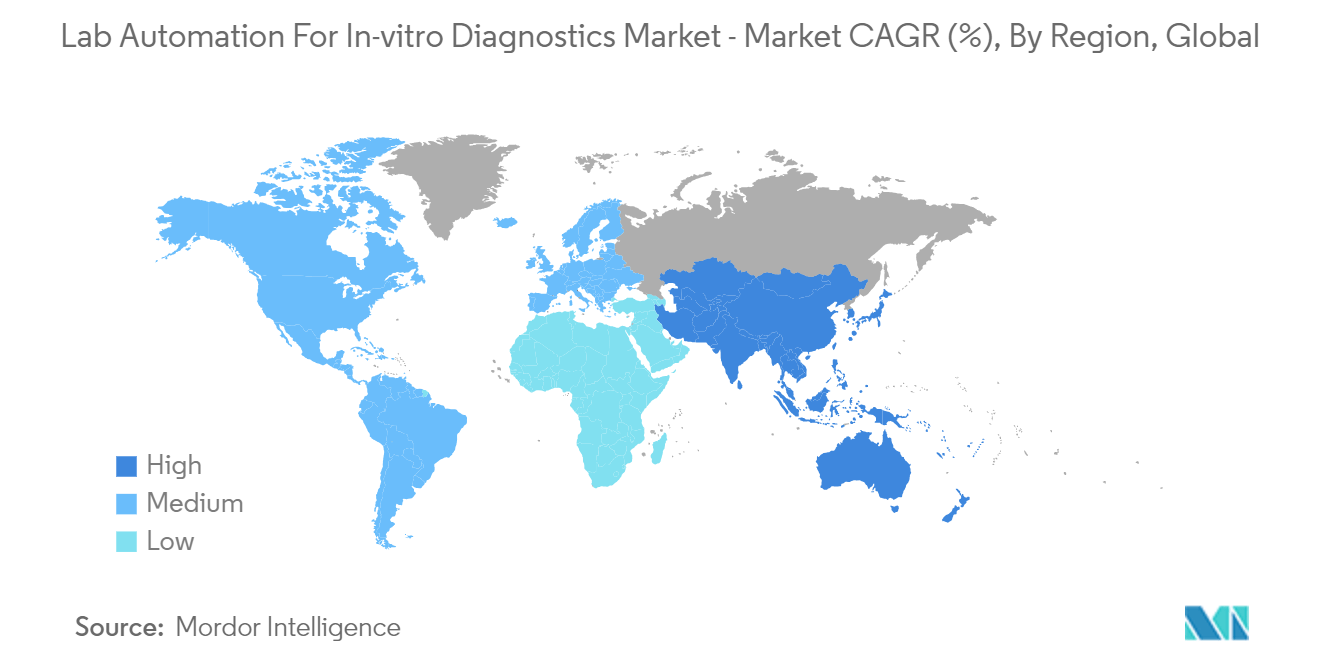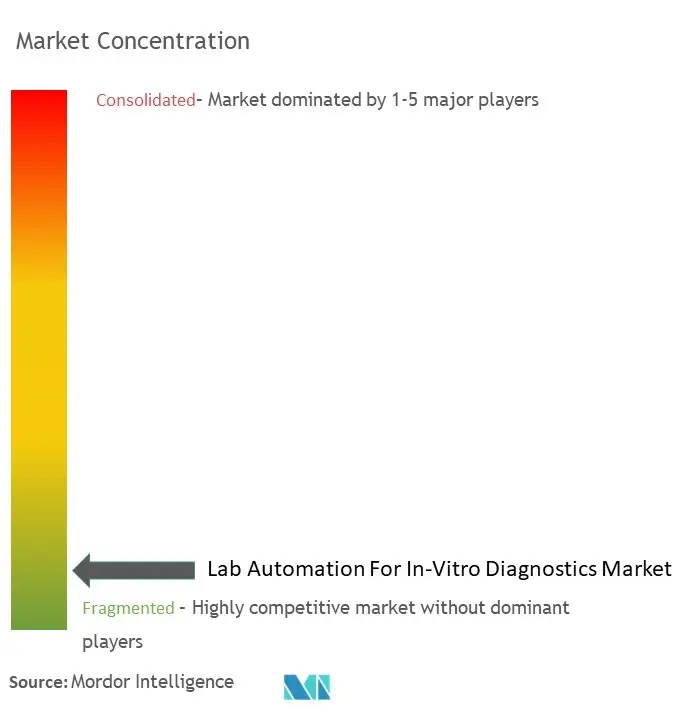Lab Automation For In-Vitro Diagnostics Market Size

| Study Period | 2019 - 2029 |
| Market Size (2024) | USD 5.75 Billion |
| Market Size (2029) | USD 7.80 Billion |
| CAGR (2024 - 2029) | 6.30 % |
| Fastest Growing Market | Asia Pacific |
| Largest Market | North America |
Major Players.webp)
*Disclaimer: Major Players sorted in no particular order |
Lab Automation For In-Vitro Diagnostics Market Analysis
The Lab Automation For In-Vitro Diagnostics Market size is estimated at USD 5.75 billion in 2024, and is expected to reach USD 7.80 billion by 2029, growing at a CAGR of 6.30% during the forecast period (2024-2029).
The increase in testing due to the pandemic and the development of automated in-vitro diagnostic systems for labs to provide quick, precise, and error-free diagnoses can be attributed to market growth.
- Lab automation is the process of using specimen-processing equipment to conduct clinical research. This procedure is carried out in order to develop new technology in order to increase productivity and decrease time cycles. In-vitro diagnostics is used in various settings, including laboratories, clinics, educational institutions, diagnostic centers, and private homes.
- The IVD product portfolio includes devices that aid clinical chemistry and immunoassays, urinalysis, point-of-care testing, and patient self-testing devices. The market is expanding as a result of significant players introducing an increasing number of IVD (in vitro diagnostics) products.
- Lab automation is becoming more common, particularly in the development of IVD medical devices. On an unprecedented scale, technology is assisting in increasing the productivity and throughput of in vitro diagnostics. Furthermore, the IVD market is expected to benefit from cognitive machine-learning capabilities and Big Data to supplement diagnostic test information and technologies to enable seamless connectivity between multiple instrument systems. Automation solutions will be in high demand as a result of such technological advancements.
- The increase in R&D activities in the pharmaceutical industries and the increase in demand for process automation for food safety are driving the growth of lab automation for the in-vitro diagnostics market. The increased adoption of these systems as a result of workflow standardization and stringent regulatory control in the healthcare industry influences the growth of lab automation for the in-vitro diagnostics market.
- Significant investments in advanced technologies and business model transformation, driven by products and value-added services, are expected to propel the market. Furthermore, the rapid spread of existing diseases and the discovery of new diseases increase the demand for early treatment and diagnosis. This is expected to increase the rate of clinical diagnostic applications, fueling the adoption of lab automation solutions.
- Automating in-vitro diagnostic devices allows the healthcare diagnostic industry to drastically reduce potential errors, detect infection, diagnose medical conditions, prevent disease, and monitor drug therapies more accurately. For example, in pandemic outbreaks, robotics can be used to reduce infection exposure, distribute medications and food, assess vital signs, promote border control, and automate disinfection.
- Furthermore, incorporating AI and analytical tools into laboratory workflows expands the lab automation market's profitable opportunities. However, a lack of skilled laboratory professionals and the limited feasibility of technology integration in analytical labs will challenge and hinder the in-vitro diagnostics lab automation market.
- The COVID-19 pandemic's continued market impact and increased consumer demand can be attributed to molecular diagnostics. Flu and COVID-19, for example, have symptoms that are difficult to distinguish. Furthermore, with the outbreak of COVID-19, several regions have seen an increase in the number of tests performed to detect the virus, necessitating lab automation technologies.
Lab Automation For In-Vitro Diagnostics Market Trends
Adoption of Robotics Arms Aids the Market Growth
- In-vitro diagnostics (IVD) has become indispensable in the healthcare system by providing critical information to diagnose diseases and guide therapeutic decisions. The scope of robotic surgery, the transition from open to laparoscopic surgery, and the demand for surgeons with expertise in complex robotic medical procedures will all expand.
- Clinical diagnostics and in vitro diagnostic (IVD) markets benefit from current advancements in automation and robotics, such as enhanced liquid handling robot solutions rather than individual pipetting chores or other types of manual handling. Robotic ultrasound has been tested in various settings, including operating rooms, remote clinics, and space.
- Robotic arms are increasingly used in research laboratories for applications requiring flexibility, efficient space utilization, and seamless integration of lab peripherals. Adoption has grown over time due to the ease with which the arms can be programmed. As a result, the market will be driven by the increased adoption of robotic arms for lab automation.
- The most common application of robotics in laboratories is machine tending or pick and place to reduce labor requirements and increase productivity. However, thanks to advancements in modular equipment, even small laboratories can reap the benefits of automation. With the assistance of various vendors, laboratories of all sizes are quickly realizing the many advantages of robotic laboratory automation.
- Because of technological advancements and increased demand for results, laboratories are increasingly utilizing automated systems. Because of its precision, improved data management capabilities, reduced repetitiveness, and eventually less human intervention, lab automation is becoming more popular, resulting in higher throughput and accuracy. For example, a robot arm for sorting blood samples reduces hospital diagnostic center personnel's workload while ensuring safety.
- Moreover, IoT-enabled systems provide server control and monitoring of various sensors and can be easily configured to handle additional hardware interface modules. Sensors installed in robots and loaded onto devices may aid data collection and communication with cloud servers and other devices. Furthermore, laboratories can maintain data with high levels of security while providing accurate and unaltered data via IoT.

North America is Expected to Hold Significant Market Share
- North America dominates the lab automation for the in-vitro diagnostics market due to the presence of large pharmaceutical companies and the rapid increase in investment in the drug discovery and genomics sectors. The United States, on the other hand, is expected to have a significant growth rate during the forecast period due to the increased development of novel technologies, rapid population growth, and continuous technological advancements.
- North America has been a leader in clinical research for many years. Pfizer, Novartis, GlaxoSmithKline, J&J, and Novartis are among the major pharmaceutical companies headquartered in this region. In addition, the area has the greatest concentration of contract research organizations (CROs). Some significant CROs are Laboratory Corp. of America Holdings, IQVIA, Syneos Health, and Parexel International Corp.
- Because of the availability of government funds, stringent FDA regulations, the growing use of molecular diagnostics in genetic disorders and cancer screening, and most of the major players in this region, the region is expected to account for a major market share.
- Additionally, the growing number of surgeries and the prevalence of various chronic diseases drive demand for automation in the clinical diagnostics industry. The American Orthopedic Surgeons (AAOS) predicts that approximately 3.0 million total knee arthroplasty surgeries will be performed in the United States by 2030. The diagnosis of these and other chronic conditions necessitates sample collection, which increases demand for the market under consideration.
- Moreover, increased access to superior technologies, increased demand for laboratory automation, and the expansion of molecular diagnostics for genetic disorders and cancer screening in the United States may all boost market demand in North America. SmartLabs, a Boston-based Laboratory-as-a-Service (LaaS) leader, announced plans to open its first facility in the city in August 2022, in addition to SmartLabs' advanced resourcing in Boston and the Bay Area, which is expected to become the city's most prominent life sciences research and production space upon completion in 2025.

Lab Automation For In-Vitro Diagnostics Industry Overview
The Lab Automation For In-Vitro Diagnostics Market is highly fragmented with the presence of major players like Cognex Corporation, Roche Holding AG, Thermo Fisher Scientific Inc., Danaher Corporation, and Agilent Technologies Inc. Players in the market are adopting strategies such as partnerships and acquisitions to enhance their product offerings and gain sustainable competitive advantage.
- August 2023 - Roche Diagnostics, the diagnostic business unit of F. Hoffmann-La Roche, and Japanese diagnostics company Sysmex have expanded their existing global business partnership agreement. As part of the updated framework, the companies reaffirm their commitment to their long-standing collaboration.
- May 2023 - Werfen signed a new long-term partnership agreement with Thermo Fisher Scientific for the global distribution of a TCAutomation laboratory automation system in the specialized field of Hemostasis Diagnostics.
Lab Automation For In-Vitro Diagnostics Market Leaders
-
Cognex Corporation
-
Roche Holding AG
-
Thermo Fisher Scientific Inc.
-
Danaher Corporation
-
Siemens Healthineers AG
*Disclaimer: Major Players sorted in no particular order

Lab Automation For In-Vitro Diagnostics Market News
- October 2023 - Roche announced the U.S. launch of the cobas connection modules (CCM) Vertical, the elevator and overhead components of its fully automated and modular CCM system to assist low-, mid-, and high-volume laboratories in optimizing space, productivity, and patient care.
- February 2023 - Siemens Healthineers, a leading medical technology company, and Unilabs, a leading diagnostic services provider, have announced a multi-year agreement worth more than EUR 200 million (USD 216.58 million). Unilabs has invested in top-tier Siemens Healthineers technology and will acquire more than 400 laboratory analyzers to improve its laboratory infrastructure and provide unrivaled service to its customers.
Lab Automation for In-vitro Diagnostics Market Report - Table of Contents
1. INTRODUCTION
- 1.1 Study Assumptions and Market Definition
- 1.2 Scope of the Study
2. RESEARCH METHODOLOGY
3. EXECUTIVE SUMMARY
4. MARKET DYNAMICS
- 4.1 Market Overview
-
4.2 Industry Attractiveness - Porter's Five Forces Analysis
- 4.2.1 Threat of New Entrants
- 4.2.2 Bargaining Power of Buyers
- 4.2.3 Bargaining Power of Suppliers
- 4.2.4 Threat of Substitute Products
- 4.2.5 Intensity of Competitive Rivalry
- 4.2.6 Industry Value Chain Analysis
-
4.3 Market Drivers
- 4.3.1 Flexibility and Adaptability of Lab Automation Systems
- 4.3.2 Digital Transformation for Laboratories with IoT
-
4.4 Market Restraints
- 4.4.1 Slow Adoption Rates by Small and Medium Laboratories
- 4.4.2 Lack of Skilled Laboratory Professionals
- 4.5 Assessment of COVID-19 Impact on the Industry
5. MARKET SEGMENTATION
-
5.1 By Equipment
- 5.1.1 Automated Plate Handler
- 5.1.2 Automated Liquid Handler
- 5.1.3 Robotic Arm
- 5.1.4 Automated Storage and Retrieval System
- 5.1.5 Analyzer
-
5.2 By End User
- 5.2.1 Academic
- 5.2.2 Laboratory
- 5.2.3 Other End Users
-
5.3 By Geography
- 5.3.1 North America
- 5.3.2 Europe
- 5.3.3 Asia Pacific
- 5.3.4 Latin America
- 5.3.5 Middle East and Africa
6. COMPETITIVE LANDSCAPE
-
6.1 Company Profiles
- 6.1.1 Cognex Corporation
- 6.1.2 Roche Holding AG
- 6.1.3 Thermo Fisher Scientific Inc.
- 6.1.4 Danaher Corporation
- 6.1.5 Agilent Technologies Inc.
- 6.1.6 Abbott Laboratories
- 6.1.7 PerkinElmer Inc.
- 6.1.8 Tecan Group Ltd
- 6.1.9 Becton, Dickinson and Company
- 6.1.10 Siemens Healthineers AG
- *List Not Exhaustive
7. INVESTMENT ANALYSIS
8. MARKET OPPORTUNITIES AND FUTURE TRENDS
** Subject To AvailablityLab Automation For In-Vitro Diagnostics Industry Segmentation
In-vitro diagnostics (IVD) tests are basically medical devices that could be in the form of reagents, techniques, instruments, or a combination of these used in vitro for the examination of specimens, such as blood, urine, or tissue, with the goal of obtaining a diagnosis from assays in a controlled environment. Diagnostic tests are usually conducted in laboratories, private or public, equipped with appropriate and sometimes expensive instrumentation and staffed with trained and qualified personnel to perform the tests.
The lab automation for the in-vitro diagnostics market is segmented by equipment (automated plate handler, automated liquid handler, robotic arm, automated storage, and retrieval system and analyzer), end user (academic and laboratory), and geography (North America, Europe, Asia Pacific, Latin America, Middle East and Africa). The report offers the market size in value terms in USD for all the abovementioned segments.
| By Equipment | Automated Plate Handler |
| Automated Liquid Handler | |
| Robotic Arm | |
| Automated Storage and Retrieval System | |
| Analyzer | |
| By End User | Academic |
| Laboratory | |
| Other End Users | |
| By Geography | North America |
| Europe | |
| Asia Pacific | |
| Latin America | |
| Middle East and Africa |
Lab Automation for In-vitro Diagnostics Market Research FAQs
How big is the Lab Automation For In-Vitro Diagnostics Market?
The Lab Automation For In-Vitro Diagnostics Market size is expected to reach USD 5.75 billion in 2024 and grow at a CAGR of 6.30% to reach USD 7.80 billion by 2029.
What is the current Lab Automation For In-Vitro Diagnostics Market size?
In 2024, the Lab Automation For In-Vitro Diagnostics Market size is expected to reach USD 5.75 billion.
Who are the key players in Lab Automation For In-Vitro Diagnostics Market?
Cognex Corporation, Roche Holding AG, Thermo Fisher Scientific Inc., Danaher Corporation and Siemens Healthineers AG are the major companies operating in the Lab Automation For In-Vitro Diagnostics Market.
Which is the fastest growing region in Lab Automation For In-Vitro Diagnostics Market?
Asia Pacific is estimated to grow at the highest CAGR over the forecast period (2024-2029).
Which region has the biggest share in Lab Automation For In-Vitro Diagnostics Market?
In 2024, the North America accounts for the largest market share in Lab Automation For In-Vitro Diagnostics Market.
What years does this Lab Automation For In-Vitro Diagnostics Market cover, and what was the market size in 2023?
In 2023, the Lab Automation For In-Vitro Diagnostics Market size was estimated at USD 5.39 billion. The report covers the Lab Automation For In-Vitro Diagnostics Market historical market size for years: 2019, 2020, 2021, 2022 and 2023. The report also forecasts the Lab Automation For In-Vitro Diagnostics Market size for years: 2024, 2025, 2026, 2027, 2028 and 2029.
Lab Automation For In-vitro Diagnostics Industry Report
Statistics for the 2024 Lab Automation For In-Vitro Diagnostics market share, size and revenue growth rate, created by Mordor Intelligence™ Industry Reports. Lab Automation For In-Vitro Diagnostics analysis includes a market forecast outlook to for 2024 to 2029 and historical overview. Get a sample of this industry analysis as a free report PDF download.



